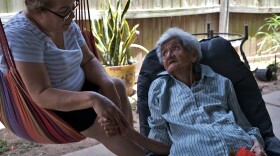A hundred years ago the Sears and Roebuck catalog, in addition to ordinary household goods, carried numerous advertisements for coffins, wreaths, and clothes to wear to funerals. The average life span was short: every family had first-hand exposure to death and dying.
Today the life span has been extended and death is hidden away in hospitals and hospices. Aging, dependency, dying and death have joined politics and religion as subjects not to be discussed at dinner parties.
In this climate Roz Chast, a cartoon writer for The New Yorker magazine, has written a memoir about her experiences with her parents and the forbidden topics of old age and death, titled Can’t We Talk About Something More Pleasant? In this graphic novel, she chronicles the events that catch up with her aging parents: her father has senile dementia and her mother falls and becomes bedridden. Chast records in cartoon fashion the life of her mother and father who have lived in the same apartment in Brooklyn for 48 years as her father loses his memory and her mother loses her ability to boss everyone.
In the course of describing and drawing pictures of the events that eventually lead to both parents being “institutionalized” in a nursing home near where Chast lives, there are flashbacks to her childhood, descriptions of her battles with her parents, and revealing family stories about the dominance of her mother in the family.
As an only child, the task of arranging care and providing care becomes Chast’s obligation and burden. As many of us would be, she is both full of love for them and resentment as her parents often act irrationally and contrary to their best interests. Chast describes hilarious and painful events. After her parents are out of the apartment and in the assisted living facility, she discovers numerous unused appliances they had received for starting bank accounts over a period of forty years. Some of the banks no longer existed although her father kept meticulous care of the bankbooks.
One of the more poignant and comic moments comes when her mother is hospitalized and she has to take her father out of his apartment. He becomes extremely anxious about the bankbooks and worries that the neighbors will enter the apartment and steal them.
One sobering motif in her book has to do with the inordinate expenses associated with having two parents in assisted living, then a nursing home, hospice, back to the nursing home with additional round the clock help, until they both give out and die in their 90s, her dad at 95 and two years later her mom at 97.
Many of the costs are not covered by insurance and have to be paid out of the parent’s savings. Chast is relieved that there are funds but also annoyed at the cost as every dollar spent to extend their lives takes away from her inheritance. She records in detail the large amounts required for care, for example, monthly $7,400 for the assisted living apartment plus $200 for furniture and another $600 for “the personal support plan.” These exorbitant fees raise the issue of whether the quality of life being sustained is worth the price.
Chast felt an endearing love for her father but had an on-going battle with her mother, who from her childhood had told Chast that she was not her friend, but her mother. During the two years, she had to care for her mother after her father died, the life-long conflict with her causes Chast a considerable amount of grief.
During the final days of her mother’s life, Chast makes pencil drawings of her mother’s face. As anyone who draws knows, this requires an extended time of looking. The inclusion of these pictures at the end of her book is especially moving. If you have aging parents or if you are an aging parent as I am, then Can’t We Talk About Something More Pleasant? is a book worth reading and talking about, in spite of its title.







